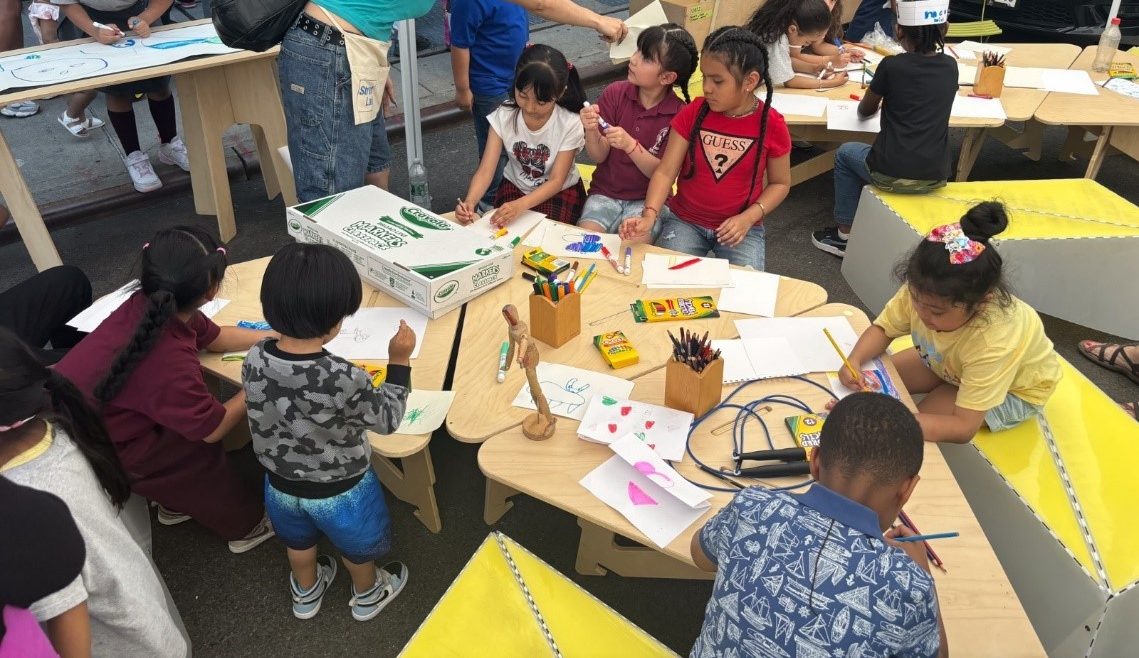School’s open — for more open streets, that is.
A record number of school "open streets" will operate across the city when the school year starts next week, Department of Transportation officials announced on Thursday.
There will be 71 streets outside schools closed to cars this year — up from 64 last year and 51 the year before, DOT said. The program aims to improve safety, make pick-ups and drop-offs smoother, and give the kids more outdoor space. There are approximately 1,400 public school buildings in the city, according to New York City Public Schools.
“The streets have historically been a place for children to play and socialize,” said DOT Commissioner Ydanis Rodríguez. "Through our Open Streets program, we have created a new framework to give this space back to our school children to safely learn, develop new skills, and make pick-ups and drop-offs much easier for parents and guardians."
Funding for the program comes in part from the Public Space Equity Program, DOT’s recent $30 million commitment to create more plazas and open streets. The new sites are in "under-resourced neighborhoods," officials said.
In addition to the Public Space Equity Program funding, DOT will, for the first time, directly fund management, operations and programming of school streets starting in 2025. Applications open in October for the 2025 program.
Every street near a school should be a school street. Our youngest New Yorkers deserve to safely walk to school, learn, and play just like the old days. 🌞🤸
— Open Plans (@OpenPlans) October 20, 2023
Thanks @Streetfilms for capturing the joy at Brooklyn's newest! pic.twitter.com/3Ijz4qvTh7
The “Full Closure: Schools” open streets allow participating schools permission to close roads to vehicles for drop-off and pick-up operations, recess and outdoor learning — with huge potential benefits for student safety.
A 2022 Streetsblog investigation found that streets outside schools had higher rates of crashes and injuries than the city average — especially in areas where most students are poor.
The city has a roughly 100-year history of barring cars on streets near schools. The former "Playstreets" program began under former Mayor John Lindsay in 1968, closing single-blocks to cars so kids could use the street as a makeshift park. The open streets program began at the start of the pandemic in 2020 brought the concept back to city schools. Communities and schools have taken it upon themselves to reclaim the streetscape for pedestrians, supported by a city program that officials made permanent in 2021.
City support is crucial in the program's maintenance — and the number of open streets outside has shrunk since late 2021, when there were over 100.
Of the 71 sites operating this year, one will be in Staten Island, 12 in the Bronx, 12 in Brooklyn, 20 in Queens and 26 in Manhattan. The city will work with Street Lab to help facilitate the sites. The non-profit organization helps create "pop-up" programs for public space by providing kits with moveable street furniture.
“This is about more than changing streets, it is about giving people the feeling of walking out the school doors into a public space that feels safer, healthier, and more connected,” Leslie Davol, executive director of Street Lab, said in a statement.

For schools located on existing open streets, DOT will continue to work to make permanent infrastructure investments, the agency said.
The 34th Avenue Open Street, known as Paseo Park, in Jackson Heights, is one example of a school-centered open street that is now going through the process of being made into a permanent park. Seven schools sit less than a block from the open street, which gives them access to variety of programming for kids and families.
Schools Streets has helped bring more pedestrian and kid-friendly streets to parts of the city that lack them — such as outside P.S. 129 in College Point, Queens.
This afternoon I stopped by PS 129’s Open Streets event to celebrate the approval of their open street request. The open street will be in effect during school hours every school day and will facilitate a smoother pick up and drop off, as well as give students more space to play!… pic.twitter.com/9NtYcJX6ie
— Councilwoman Vickie Paladino (@CMvpaladino) June 10, 2024
"Every single new school street is something to celebrate," said Sabina Unni, Schools Planner at Open Plans (which shares a parent organization with Streetsblog. "This program is deeply transformative to school communities and the City should do everything it can to support and grow the number of participating schools and reduce the barriers to success — like funding, staffing, and outreach. We want school streets everywhere."






